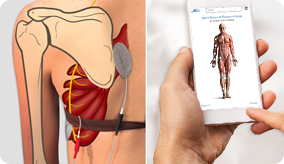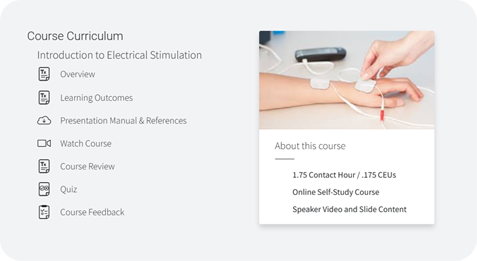
Educational Resources
Axelgaard is proud to offer free educational resources via our video series and our interactive visual guide. The guide is viewable both on desktop and mobile and all of our videos can be watched online or downloaded for offline viewing.
Interactive NMES Electrode Placement Guide

In collaboration with Dr. Lucinda Baker of the University of Southern California’s Division of Biokinesiology and Physical Therapy, Axelgaard’s Electrode Placement Guide is a free, interactive resource for electrode placement. This informative guide features 41 instructional videos, illustration-enhanced electrode placement photos, and relevant information on muscular and neurological anatomy.
OT Course on Electrical Stimulation

In collaboration with Salia Rehab, this course guides learners through the general considerations and specific applications and treatment techniques for electrotherapeutic interventions. Learners will review best practices for safe, effective, and efficient application of electrical stimulation modality treatments to a variety of clinical presentations. In addition, concepts associated with use of electrical stimulation in occupational performance will also be reviewed.
The online class is intended for medical professionals (e.g. OT/OTA, PT/PTA, Physicians, etc.) directly related to the rehabilitation of a patient or client.
NMES Electrode Placement Videos
We are pleased to sponsor the Electrode Placement and Functional Movement series presented by Dr. Lucinda Baker, Associate Professor at USC Division of Biokinesiology and Physical Therapy. These videos provide comprehensive information on the preparation and use of electrodes for effective neurostimulation treatment. All electrodes used in the video presentations are PALS® neurostimulation electrodes.
Individual chapters and the full DVD ISO file are available for free download alongside each video for offline viewing.
Chapter 4
Download Chapter
Download full DVD ISO
HZ: 35
Waveform: Asymmetric
Stimulation Grade: N/A
Electrode placements for shoulder flexion and abduction can be seen here with one electrode over the anterior deltoid and the other over the middle deltoid. The acromium is marked with the marker. In our first placement the negative electrode of the asymmetric waveform is placed over the anterior deltoid and you can see the resultant stimulation is one of dominantly flexion.
The therapist is now putting the stimulator on pause and he is going to switch the polarity so that the middle deltoid electrode is now the negative electrode and the anterior deltoid will become the positive electrode. You can see the resultant stimulated contraction is one of dominant abduction. Placing the stimulator on pause, the electrode leads are being disconnected. A second stimulator that is programmed with a symmetric biphasic waveform is being connected. And now as the therapist increases the amplitude you will notice that both electrodes, anterior and middle deltoid, are equally excitable resulting in a motion that would be referred to as scaption, a combination of flexion and abduction.